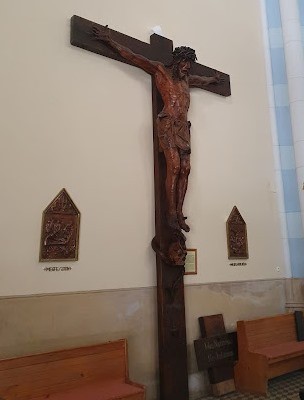The cross that stands at the opening and closing mass of the 52nd International Eucharistic Congress in Budapest, on Hősök Square, came to our country from Tyrol. The researcher of the history of the cross is József Bokody, whose writing Magyar Kurír .
"Carrying the cross" is a centuries-old tradition among Tyroleans at church holidays and events. This cross was brought to Budapest by six hundred pilgrims dressed in Tyrolean national costume in 1930, on the occasion of the 900th anniversary of the death of Prince Szent Imre . The creator, Andreas Crepaz, a wood carving artist from Halli, himself participated in the Budapest pilgrimage.
The cross is six meters high; and the wooden body on it is 286 centimeters. The huge, heavy cross was carried by five Tyrolean men on each side with the help of a cross-braced bar on the lower part, and it was supported against tilting by two bars attached to the side legs. The team of fourteen had to be changed frequently.

The Budapest XIV. The bus garage on Szabó József Street in the district was already completed in August 1930, but at that time it was not yet handed over to its original purpose - that is why the main meetings of the national St. Imre celebrations could be held here. The building was then named the Szent Imre bus garage; this was changed to Récsi garage in 1948.
After the Szent Imre celebrations, the cross was moved to the Szent Domonkos parish church on Thököly út. It is still located here, hanging on the side wall to the left of the main entrance.
In 1933, the IV. Scout World Jamboree. For this occasion, the Tyrolean scouts borrowed the cross and marched with it at the opening ceremony on August 2. In the August 4, 1933 edition of the Képes Pesti Hírlap, a photo of this was published with the caption: "The Tyrolean scouts march with a giant wooden cross in the parade." The huge cross rose overhead and was visible throughout the arena. The crucifix stood in the main square of the Austrian camp during the jamboree.
Szilárd Kovács's famous shot of the cross is also on the postcard published by the Hungarian National Association. Below the picture is the inscription "We rise" and on the reverse side it says: "Gödöllő, Jamboree - 1933. In the left corner of the picture, at the right hand of Christ, the wooden blocks from the wonderful play of nature are Greater Hungary and Csonka-Hungary, which was torn apart by the "peace of Trianon" they show his image." It is mainly due to this that this image and the Tyrolean cross have become famous in Hungary and around the world. The scouts often visited it, since the cross was always at the center of their spirituality.
Until 1948, the cross was carried by the passengers of the Keleti pályaudvar in the processions of the St. Domonkos Church.
The Cross of Tyrol was there II. On the occasion of Pope János Pál's visit to Hungary in 1991, on the 20th of August, the feast of King St. Stephen, at the closing mass held in Hősök square. There, it towered over the altar and the relic of St. Jobb - and in September 2021, it can be seen there again in Hősök Square. He was there at the opening mass of the 52nd International Eucharistic Congress and will be there today at the closing mass, which will be presented by Pope Francis.













